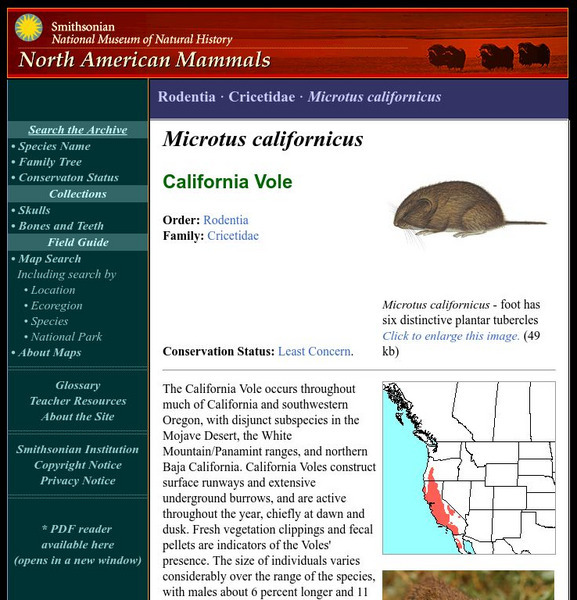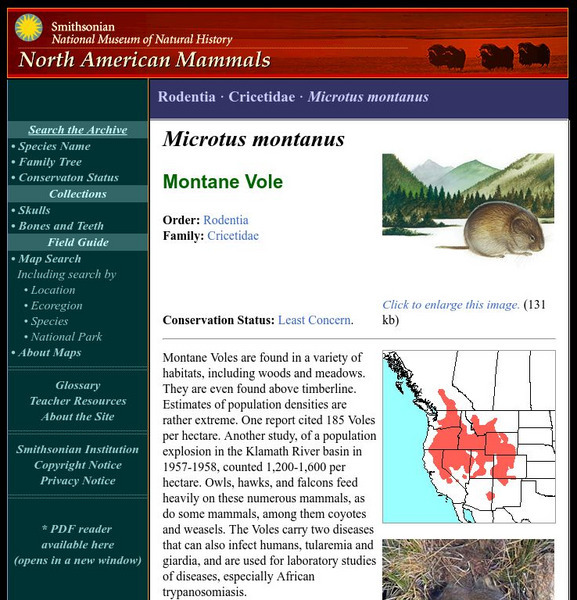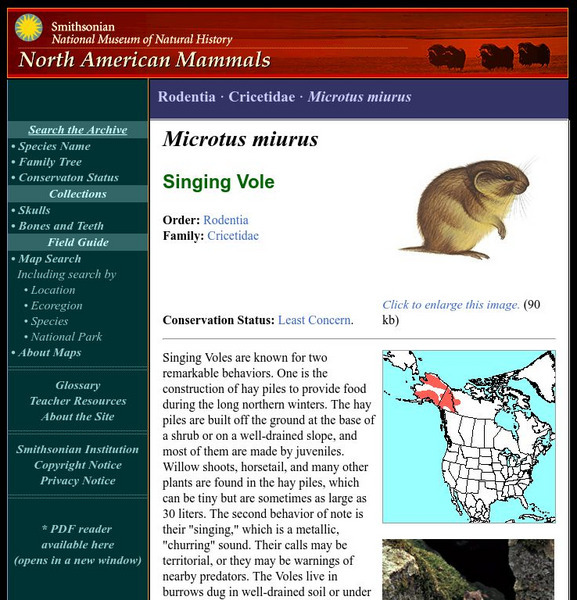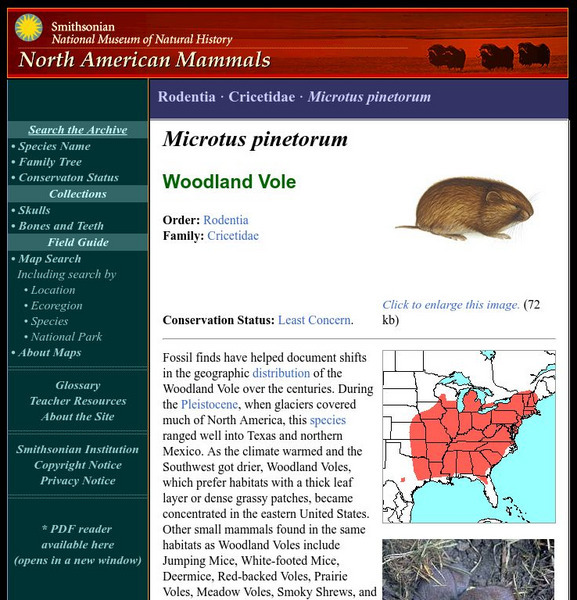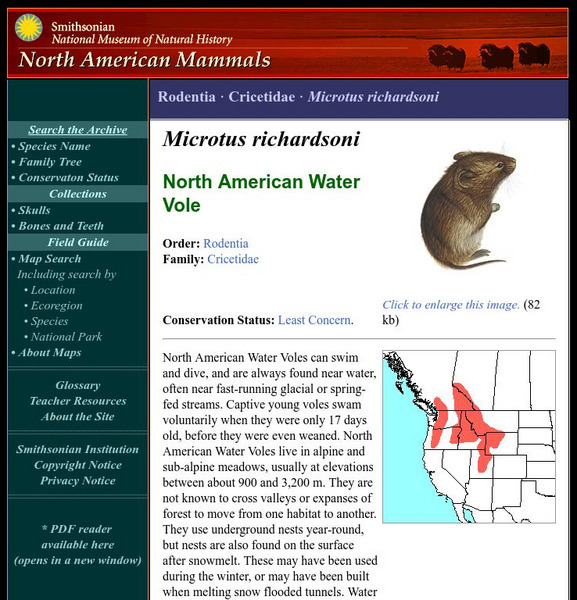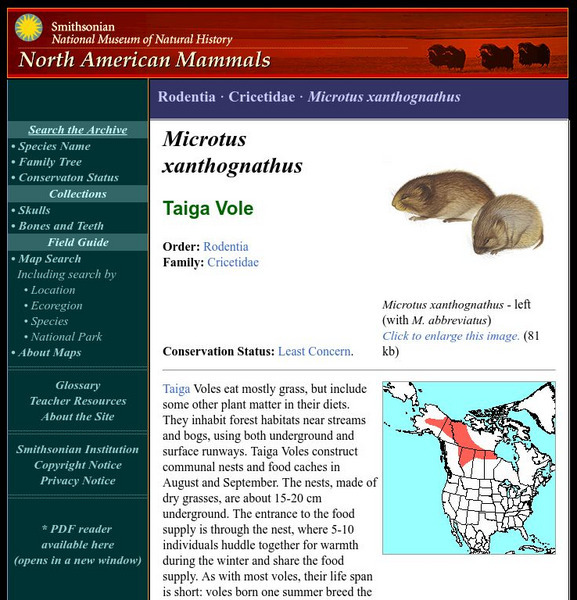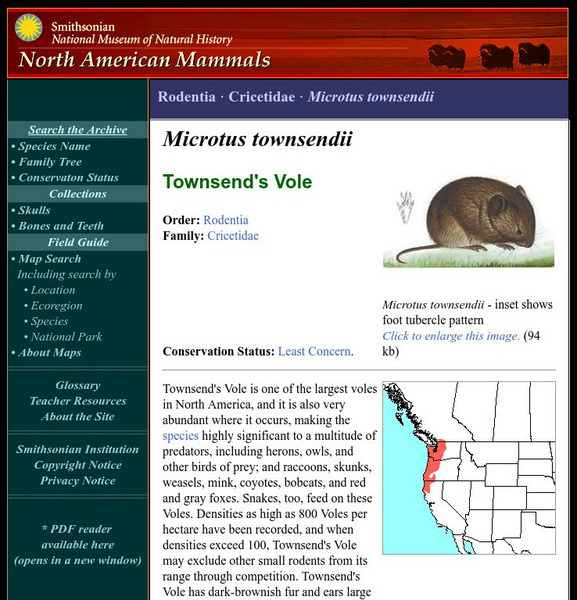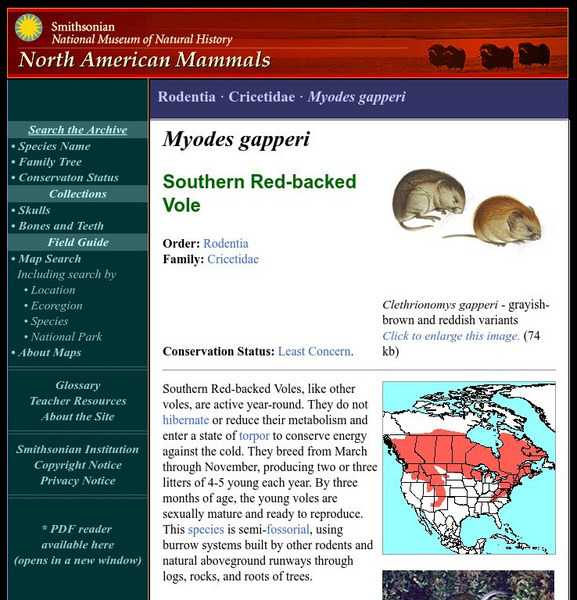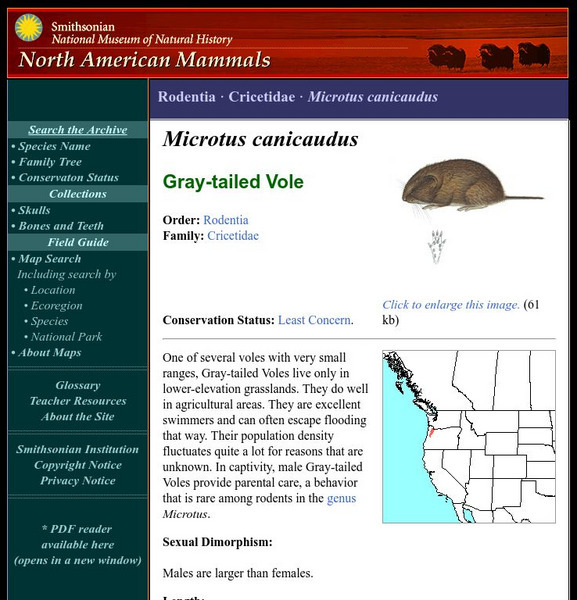Regents of the University of Michigan
Animal Diversity Web: Lemmings and Voles
Lemmings and voles belong to the rodent subfamily Arvicolinae. Comprehensive information about these animals is presented, including the positive and negative economic impacts they have on humans. This page has excellent photographs of...
Smithsonian Institution
National Museum of Natural History: American Mammals: California Vole
The California Vole occurs throughout much of California and southwestern Oregon, with disjunct subspecies in the Mojave Desert, the White Mountain/Panamint ranges, and northern Baja California. California Voles construct surface runways...
Smithsonian Institution
National Museum of Natural History: American Mammals: Beach Vole
Found only on Muskeget Island, the Beach Vole became isolated from its closest relative, the Meadow Vole, about 3,000 years ago during a glacial melt and rise in sea level. It is the only mammal endemic to Massachusetts, the result of...
Smithsonian Institution
National Museum of Natural History: American Mammals: White Footed Vole
White-footed Voles inhabit a relatively small area of the Pacific coast of North America, from Humboldt Bay, California, north to the Columbia River. They have small eyes, and their claws are suitable for burrowing, so they probably have...
Smithsonian Institution
National Museum of Natural History: American Mammals: Red Tree Vole
The home range of a Red Tree Vole may consist of just one tree, usually a large old Douglas-fir, where the vole builds its nest, eats the needles, and gets water by licking dew drops from the needles. Nests have been found more than 50 m...
Smithsonian Institution
National Museum of Natural History: American Mammals: Sonoma Tree Vole
The Sonoma Tree Vole nests so high in trees that finding one in a forest interior is quite difficult, and many records are from individuals that were living in trees that were cut down. A few coniferous tree species provide all of the...
Smithsonian Institution
National Museum of Natural History: American Mammals: Sagebrush Vole
Sagebrush Voles usually live in colonies in semiarid, partly brushy habitat. The dominant plants where they live are sagebrush or rabbitbrush mixed with bunchgrass. Learn more about the Lemmiscus curtatus, more commonly known as a...
Smithsonian Institution
National Museum of Natural History: American Mammals: Meadow Vole
Meadow Voles have a remarkable reproductive output: they are the world's most prolific mammals. Females can breed when they are a month old and produce litters of 3-10 pups every three weeks for the rest of their lives. Learn more about...
Smithsonian Institution
National Museum of Natural History: American Mammals: Tundra Vole
Tundra Voles have the northernmost distribution of any North American species of Microtus. They are widespread in northern latitudes in Eurasia, too, where they are known as Root Voles, and probably migrated to North America across the...
Smithsonian Institution
National Museum of Natural History: American Mammals: Montane Vole
Montane Voles are found in a variety of habitats, including woods and meadows. They are even found above timberline. Learn more about the Microtus montanus, more commonly known as a Montane Vole, in this easy-to-read species overview by...
Smithsonian Institution
National Museum of Natural History: American Mammals: Singing Vole
Singing Voles are known for two remarkable behaviors. One is the construction of hay piles to provide food during the long northern winters. Learn more about the Microtus miurus, more commonly known as a Singing Vole, in this...
Smithsonian Institution
National Museum of Natural History: American Mammals: Rock Vole
As suggested by the common name, rocks are a prominent feature in the habitat of this species. Rock Voles prefer forest habitats with moss-covered rocks and boulders, thick ground cover, and accessible water. Learn more about the...
Smithsonian Institution
National Museum of Natural History: American Mammals: Long Tailed Vole
Long-tailed Voles need cool, moist habitats, so they are found mostly near the peaks of mountain ranges. Fruits and seeds make up the bulk of their diet, but they also eat fungi, bark, and leaves if necessary. Learn more about the...
Smithsonian Institution
National Museum of Natural History: American Mammals: Prairie Vole
The Prairie Vole builds well-defined runways on and below ground. Surface runways are often well worn and bare of vegetation; sometimes they are covered with a layer of grass clippings. Learn more about the Microtus ochrogaster, more...
Smithsonian Institution
National Museum of Natural History: American Mammals: Woodland Vole
Fossil finds have helped document shifts in the geographic distribution of the Woodland Vole over the centuries. During the Pleistocene, when glaciers covered much of North America, this species ranged well into Texas and northern...
Smithsonian Institution
National Museum of Natural History: American Mammals: North American Water Vole
North American Water Voles can swim and dive, and are always found near water, often near fast-running glacial or spring-fed streams. Captive young Voles swam voluntarily when they were only 17 days old, before they were even weaned....
Smithsonian Institution
National Museum of Natural History: American Mammals: Taiga Vole
Taiga Voles eat mostly grass, but include some other plant matter in their diets. They inhabit forest habitats near streams and bogs, using both underground and surface runways. Learn more about the Microtus xanthognathus, more commonly...
Smithsonian Institution
National Museum of Natural History: American Mammals: Townsend's Vole
Townsend's Vole is one of the largest voles in North America, and it is also very abundant where it occurs, making the species highly significant to a multitude of predators, including herons, owls, and other birds of prey; and raccoons,...
Smithsonian Institution
National Museum of Natural History: American Mammals: Western Heather Vole
Western Heather Voles live in mountains, near or above the timberline. Where high-elevation forests have been clear-cut, they have been seen at lower elevations. Learn more about the Phenacomys intermedius, more commonly known as a...
Smithsonian Institution
National Museum of Natural History: American Mammals: Northern Red Backed Vole
The Northern Red-backed Vole lives in dry tundra and northern boreal forests (taiga). Two distinct coat coloration patterns exist within the species, one darkly colored, and a paler version. Learn more about the Clethrionomys rutilus,...
Smithsonian Institution
National Museum of Natural History: American Mammals: Western Red Backed Vole
The Western Red-backed Vole lives in conifer forests from the Columbia River south through western Oregon to northern California. Its population densities are greatest in dense, dark forests where there is little or no understory. Learn...
Smithsonian Institution
National Museum of Natural History: American Mammals: Southern Red Backed Vole
Southern Red-backed Voles, like other voles, are active year-round. They do not hibernate or reduce their metabolism and enter a state of torpor to conserve energy against the cold. Learn more about the Clethrionomys gapperi, more...
Smithsonian Institution
National Museum of Natural History: American Mammals: Gray Tailed Vole
One of several voles with very small ranges, Gray-tailed Voles live only in lower-elevation grasslands. They do well in agricultural areas. Learn more about the Microtus canicaudus, more commonly known as a Gray-tailed Vole, in this...
Smithsonian Institution
National Museum of Natural History: American Mammals: Insular Vole
There have been only scattered observations of the Insular Vole since 1885 because the two islands in the Bering Sea off the coast of Alaska where it lives are rather inaccessible. The Voles live in burrows dug in moist lowland areas, at...



